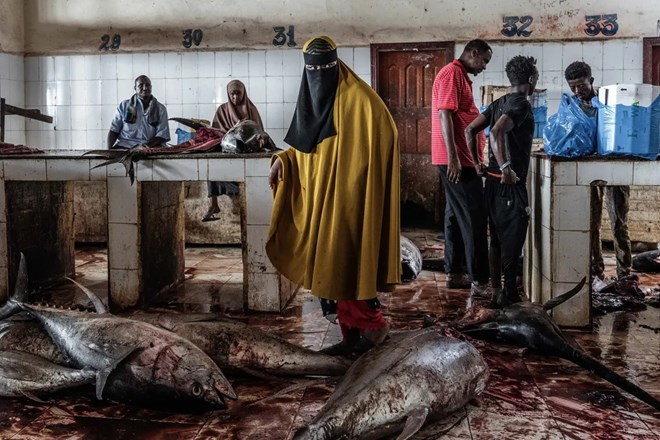
Thursday April 6, 2023
Interview by Edward Siddons

‘She looked like a kind of noblewoman’ … tuna and swordfish for sale at the market in Mogadishu, Somalia.
Taking photos here wasn’t easy. Stand still for too long and you’d get barged out of the way by busy shoppers – or whacked by a fin or a tail’
Drought, conflict and famine have racked Somalia, but there has been very little international coverage of its plight recently. I visited last November, hoping to draw attention to the humanitarian crisis facing its people, and document not just their struggles but also their resilience. I spent some time exploring the consequences of drought, the struggle of refugees and the problem of overwhelmed hospitals. But the sadness of those stories needed a counterweight. In Mogadishu, the capital, I found positive stories.
This is Hamar Weyne fish market, an important hub near the centre. I was amazed at its vibrancy. Hundreds of fishermen depend on the market to sell their catch: tuna, swordfish and the like, caught off the coast. It was full of energy, colour and people. Everyone was pushing through crowds, some struggling to carry these massive tuna out of the market. After documenting so much tragedy in the country, the market felt like a beacon of hope – a testament to the strength of people whose ordinary lives went on.
Taking photos there wasn’t easy, though. Stand still for too long and you would get whacked by a fin or a tail, or barged out of the way by busy shoppers. Moving through it, you had to watch you didn’t trip over a giant tuna or put your foot in a pile of fish guts.
I was struck by this woman the moment I saw her. There was such dignity in the way she moved, tiptoeing with grace amid the chaos. The vibrancy of the yellow against the darkness of the fish guts made her look like a kind of noblewoman going about her duties. I’m always searching for moments of serendipity – when the light falls a certain way, or a movement can be perfectly captured. This was one of those times. I had maybe a second or two. Then, as soon as I took it, she was gone. Looking at it on my return, I felt as if it had captured something of Somalia’s beauty and, unfortunately, some of its bloodshed. But, more than anything, it represented the resilience of its people.
I’m no stranger to challenging environments. I’ve worked in Chad, South Sudan, Afghanistan and gang-controlled communities in Haiti and El Salvador. I’ve witnessed the impact of poverty and conflict. But Somalia was different. There was something so acute about its suffering, the combination of crises it faces. I found it hard to shake.
Going to Somalia is not a trivial thing. Security considerations are extensive, and nothing is guaranteed. You can plan as much as you want but everything can change in an instant. On the day I took this, there was an attack on a hotel not dissimilar to mine. A month before, a double car bombing shook the city. Insecurity is a fact of life for many. It gets hairy very quickly.
Somalia’s struggles are not likely to ease in the short term. According to some calculations, it is the world’s second most vulnerable country to the climate crisis. The three million or so internally displaced persons are testament to its effects in the here and now. Only action, domestic and international, will change that.